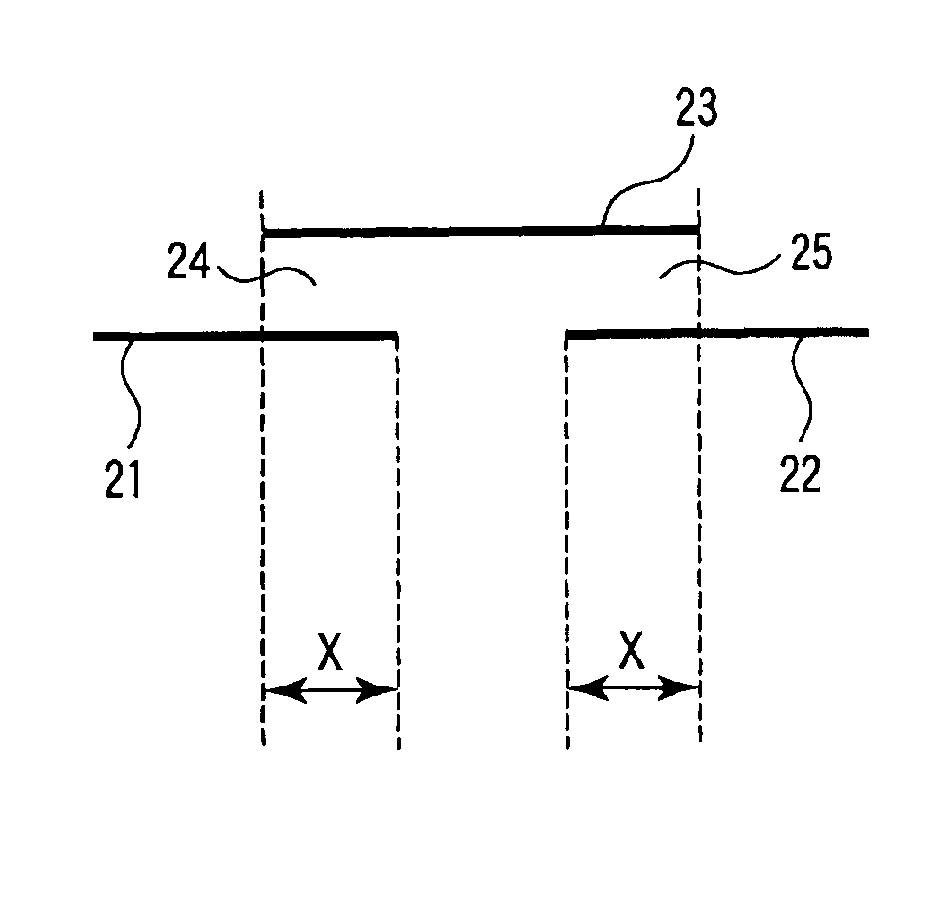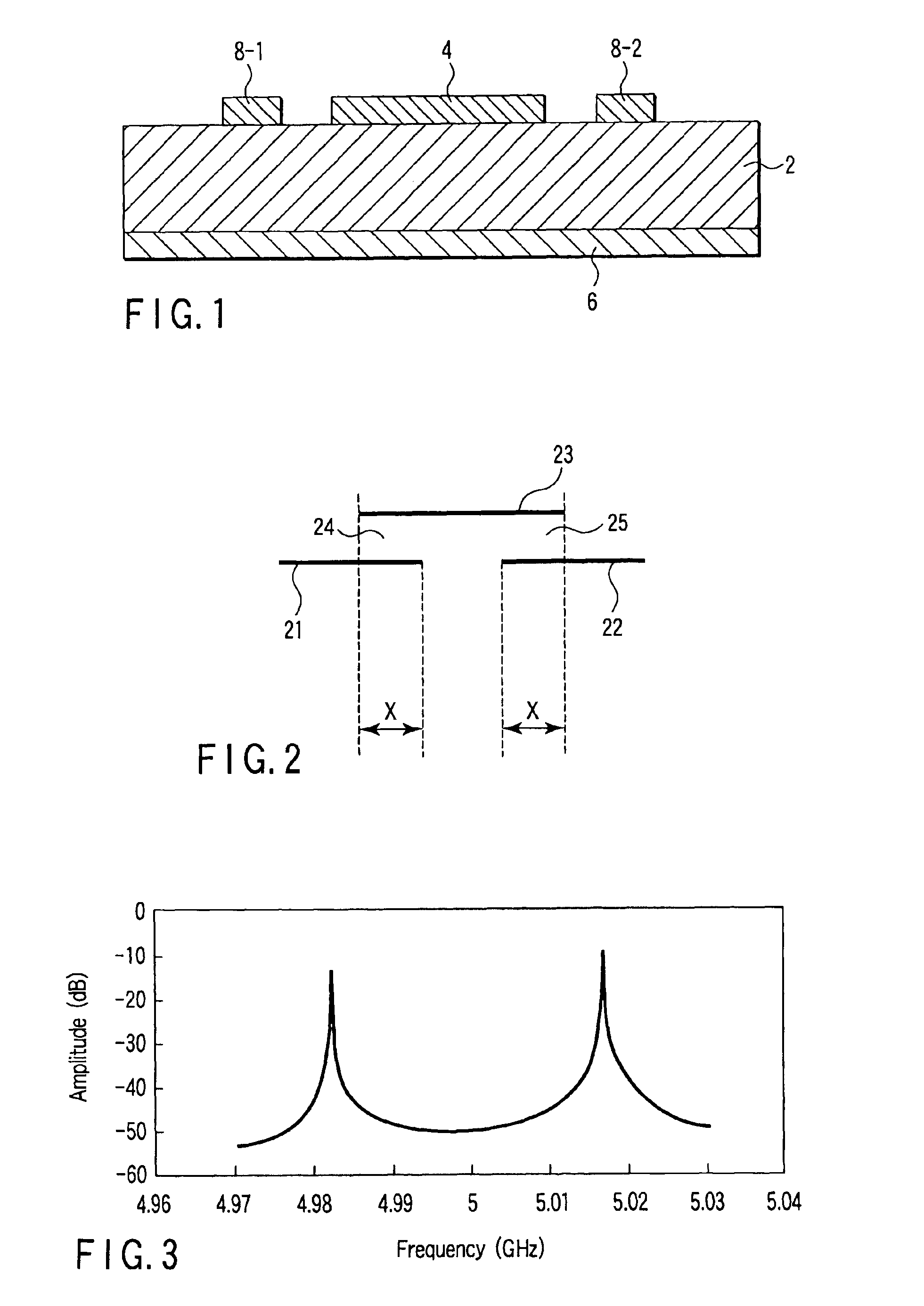Band pass filter
a filter and band pass technology, applied in the direction of waveguides, basic electric elements, electrical equipment, etc., can solve the problems of difficult achieving both the super sharp cut and the very narrow band, and the realization of the very narrow band super sharp cut filter is very difficul
- Summary
- Abstract
- Description
- Claims
- Application Information
AI Technical Summary
Benefits of technology
Problems solved by technology
Method used
Image
Examples
embodiment 1
[0056]FIG. 10 is a plane view for illustrating one pattern of a filter according to an embodiment 1 of the present invention.
[0057]Like the description based on FIG. 1, a superconducting microstrip line is formed on an MgO substrate 2 having a thickness of approximately 0.43 mm and a relative dielectric constant of approximately 10. Here, a Y-based copper oxide high-temperature superconducting thin film having a thickness of approximately 500 nm is used as a superconductor of the microstrip line, and a line width of a strip conductor is approximately 0.4 mm. The superconducting thin film 4 is manufactured by a laser evaporation method, a sputtering method, a codeposition method or the like.
[0058]The filter shown in FIG. 10 is a Chebychev type filter including six resonators 32, 34, 36, 38, 40 and 42 between input / output line paths 31 and 43 formed by excitation lines. The six half-wavelength hairpin type resonators 32, 34, 36, 38, 40 and 42 whose open sides are directed in the same ...
embodiment 2
[0060]FIG. 12 is a plane view for illustrating one pattern of a filter according to another embodiment of the present invention. The filter shown in FIG. 12 is a Chebychev filter including four resonators 51, 53, 55 and 57 between input / output line paths 50 and 58 formed by excitation lines. As the resonators, there are used one-wavelength linear type resonators 51, 53, 55 and 57. Therefore, a wavelength corresponding to a resonance frequency matches a length of each resonator. Additionally, the resonators 51, 53, 55 and 57 adjacent to each other are coupled through line paths 52, 54 and 56 bent into such a shape as shown in FIG. 8, respectively. Each of the transmission line paths 52, 54 and 56 has a length of a {fraction (7 / 4)} wavelength, a length x of each coupling portion is substantially determined as a ¼ wavelength, and this coupling portion is arranged in closest proximity to a corresponding resonator. As described above, since the length of each resonator is determined as o...
embodiment 3
[0063]FIG. 14 is a plane view for illustrating one pattern of a filter according to still another embodiment of the present invention.
[0064]In the filter shown in FIG. 14, a superconducting microstrip line path is formed on an MgO substrate (not shown) having a thickness of approximately 0.43 mm and a relative dielectric constant of 10. Here, a Y-based copper oxide high-temperature superconducting thin film having a thickness of approximately 500 nm is used as a superconductor of the microstrip line, and a line width of a strip conductor is approximately 0.4 mm. The superconducting thin film is manufactured by a laser evaporation method, a sputtering method, a codeposition method or the like.
[0065]The filter shown in FIG. 14 is a four-stage filter constituted by four linear resonators 61, 63, 65 and 67 provided between input / output line paths 60 and 68 formed by excitation lines. In the filter depicted in FIG. 14, a one-wavelength resonator is used as each resonator, and the adjacen...
PUM
| Property | Measurement | Unit |
|---|---|---|
| length | aaaaa | aaaaa |
| thickness | aaaaa | aaaaa |
| thickness | aaaaa | aaaaa |
Abstract
Description
Claims
Application Information
 Login to View More
Login to View More - R&D
- Intellectual Property
- Life Sciences
- Materials
- Tech Scout
- Unparalleled Data Quality
- Higher Quality Content
- 60% Fewer Hallucinations
Browse by: Latest US Patents, China's latest patents, Technical Efficacy Thesaurus, Application Domain, Technology Topic, Popular Technical Reports.
© 2025 PatSnap. All rights reserved.Legal|Privacy policy|Modern Slavery Act Transparency Statement|Sitemap|About US| Contact US: help@patsnap.com



